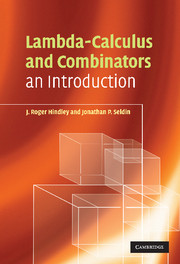Book contents
- Frontmatter
- Contents
- Preface
- 1 The λ-calculus
- 2 Combinatory logic
- 3 The power of λ and combinators
- 4 Representing the computable functions
- 5 The undecidability theorem
- 6 The formal theories λβ and CLw
- 7 Extensionality in λ-calculus
- 8 Extensionality in combinatory logic
- 9 Correspondence between λ and CL
- 10 Simple typing, Church-style
- 11 Simple typing, Curry-style in CL
- 12 Simple typing, Curry-style in λ
- 13 Generalizations of typing
- 14 Models of CL
- 15 Models of λ-calculus
- 16 Scott's D∞ and other models
- Appendix A1 Bound variables and α-conversion
- Appendix A2 Confluence proofs
- Appendix A3 Strong normalization proofs
- Appendix A4 Care of your pet combinator
- Appendix A5 Answers to starred exercises
- References
- List of symbols
- Index
16 - Scott's D∞ and other models
Published online by Cambridge University Press: 05 June 2012
- Frontmatter
- Contents
- Preface
- 1 The λ-calculus
- 2 Combinatory logic
- 3 The power of λ and combinators
- 4 Representing the computable functions
- 5 The undecidability theorem
- 6 The formal theories λβ and CLw
- 7 Extensionality in λ-calculus
- 8 Extensionality in combinatory logic
- 9 Correspondence between λ and CL
- 10 Simple typing, Church-style
- 11 Simple typing, Curry-style in CL
- 12 Simple typing, Curry-style in λ
- 13 Generalizations of typing
- 14 Models of CL
- 15 Models of λ-calculus
- 16 Scott's D∞ and other models
- Appendix A1 Bound variables and α-conversion
- Appendix A2 Confluence proofs
- Appendix A3 Strong normalization proofs
- Appendix A4 Care of your pet combinator
- Appendix A5 Answers to starred exercises
- References
- List of symbols
- Index
Summary
Introduction: complete partial orders
Having looked at the abstract definition of ‘model’ in the last two chapters, let us now study one particular model in detail. It will be a variant of Dana Scott's D∞, which was the first non-trivial model invented, and has been a dominant influence on the semantics of λ-calculus and programming languages ever since.
Actually, D∞ came as quite a surprise to all workers in λ − even to Scott. In autumn 1969 he wrote a paper which argued vigorously that an interpretation of all untyped λ-terms in set theory was highly unlikely, and that those who were interested in making models of λ should limit themselves to the typed version. (For that paper, see [Sco93].) The paper included a sketch of a new interpretation of typed terms. Then, only a month later, Scott realized that, by altering this new interpretation only slightly, he could make it into a model of untyped λ; this was D∞.
D∞ is a model of both CLw and λβ, and is also extensional. The description below will owe much to accounts by Dana Scott and Gordon Plotkin, and to the well-presented account in [Bar84], but it will give more details than these and will assume the reader has a less mathematical background.
The construction of D∞ involves notions from topology. These will be defined below. They are very different from the syntactical techniques used in this book so far, but they are standard tools in the semantics of programming languages.
- Type
- Chapter
- Information
- Lambda-Calculus and CombinatorsAn Introduction, pp. 247 - 275Publisher: Cambridge University PressPrint publication year: 2008



